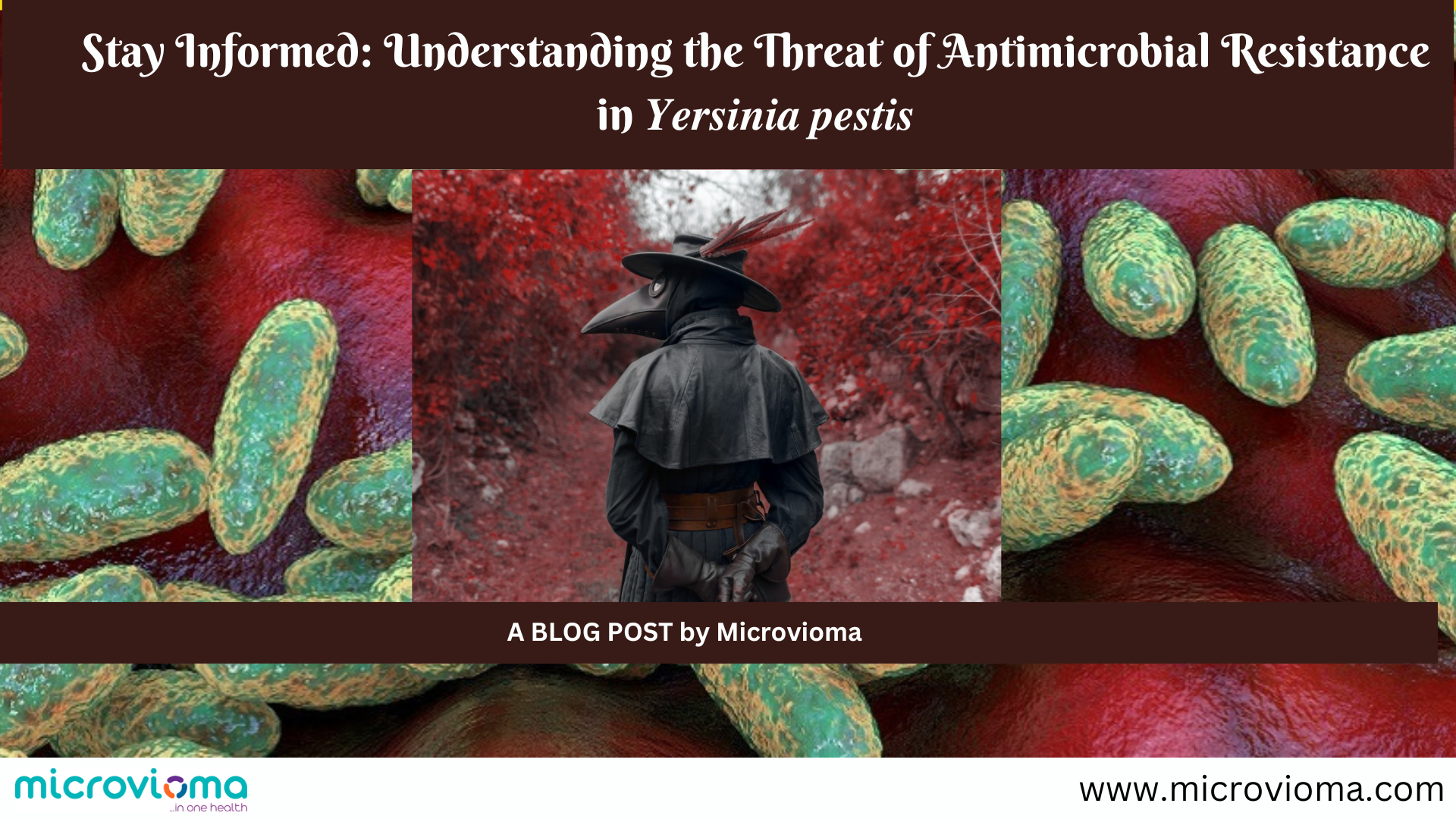𝘠𝘦𝘳𝘴𝘪𝘯𝘪𝘢 𝘱𝘦𝘴𝘵𝘪𝘴, the bacterium behind the plague, continues to be an important threat to public health, not only because of its historical significance, but also because of its developing antibiotic resistance. Understanding how this bacterium develops and spreads resistance is critical for modern medical science to combat it successfully. Lets explore the mechanisms, prevalence, and implications of antibiotic resistance in 𝘠𝘦𝘳𝘴𝘪𝘯𝘪𝘢 𝘱𝘦𝘴𝘵𝘪𝘴, highlighting why it remains a formidable enemy.
Evolution and Virulence
𝘠𝘦𝘳𝘴𝘪𝘯𝘪𝘢 𝘱𝘦𝘴𝘵𝘪𝘴 is a gram-negative, nonmotile bacterium derived from 𝘠𝘦𝘳𝘴𝘪𝘯𝘪𝘢 pseudotuberculosis. This evolution has given 𝘠𝘦𝘳𝘴𝘪𝘯𝘪𝘢 𝘱𝘦𝘴𝘵𝘪𝘴 a broad range of virulence factors, allowing it to thrive in both flea vectors and mammalian hosts. Its genome is highly flexible, allowing it to acquire new genes that improve its survival and virulence. These genetic modifications contribute significantly to the bacterium’s ability to build antibiotic resistance.
Mechanisms for Resistance
Resistance in 𝘠𝘦𝘳𝘴𝘪𝘯𝘪𝘢 𝘱𝘦𝘴𝘵𝘪𝘴 can emerge through two main mechanisms: plasmid-mediated resistance and chromosomal alterations.
Plasmid-mediated resistance: – Conjugative plasmids: These plasmids include multiple resistance genes and can be transmitted between bacteria. For example, the plasmid pIP1202 found in the 𝘠𝘦𝘳𝘴𝘪𝘯𝘪𝘢 𝘱𝘦𝘴𝘵𝘪𝘴 strain 17/95 from Madagascar carries genes that confer resistance to eight different antibiotics, including streptomycin and tetracycline.
- Self-transferable Plasmids: Another example is the plasmid pIP1203 in strain 16/95 from Madagascar, which confers streptomycin resistance.
Chromosomal Mutations: – Changes in specific chromosomal genes might cause antibiotic resistance. The rpsL gene, which encodes ribosomal protein S12, is a frequent target for such alterations. In the 𝘠𝘦𝘳𝘴𝘪𝘯𝘪𝘢 𝘱𝘦𝘴𝘵𝘪𝘴 strain S19960127 from China, a mutation in this gene resulted in high-level resistance to streptomycin.
Prevalence and Geographic Distribution
The incidence of antimicrobial-resistant 𝘠𝘦𝘳𝘴𝘪𝘯𝘪𝘢 𝘱𝘦𝘴𝘵𝘪𝘴 differs by area.
- Madagascar: This region has witnessed a number of drug-resistant strains, including 17/95 and 16/95, which are highly resistant to various antibiotics. These resistant strains, while concerning, have largely remained localized.
- China: A systematic analysis of Y. pestis strains from diverse plague foci in China revealed that one strain, S19960127, had high-level streptomycin resistance because to a rpsL mutation. The other strains were sensitive to a wide range of antibiotics.
- Other Regions: Reports from Mongolia, Vietnam, and the USA indicate the global nature of this issue. For instance, a multidrug-resistant strain was identified in Mongolia, although its genetic basis was not fully detailed.
Public Health Implications
The rise of antibiotic-resistant 𝘠𝘦𝘳𝘴𝘪𝘯𝘪𝘢 𝘱𝘦𝘴𝘵𝘪𝘴 has crucial public health concerns.
Treatment Challenges: – Antibiotic Efficacy: The efficacy of first-line medications such as streptomycin has been impaired, necessitating alternative or combination therapies. In China, combinations of streptomycin and other antibiotics have been used to improve treatment results.
- combination therapy: Using multiple antibiotics can help overcome resistance, but this strategy demands careful management to prevent further resistance development.
Surveillance and Monitoring: – Routine Testing: Regular monitoring of 𝘠𝘦𝘳𝘴𝘪𝘯𝘪𝘢 𝘱𝘦𝘴𝘵𝘪𝘴 isolates for antibiotic resistance is crucial. This comprises susceptibility testing and genome analysis to identify resistance mechanisms.
- Global Surveillance: International coordination is required to monitor the emergence of resistant strains and carry out coordinated public health actions.
Potential for Bioterrorism: – Risks of Weaponization: The use of antibiotic-resistant 𝘠𝘦𝘳𝘴𝘪𝘯𝘪𝘢 𝘱𝘦𝘴𝘵𝘪𝘴 as a bioweapon raises severe concerns. Historical study, particularly during WWII and the Cold War, has demonstrated the viability of such threats.
Preventive Measures and Future Directions
To reduce the dangers posed by antimicrobial-resistant 𝘠𝘦𝘳𝘴𝘪𝘯𝘪𝘢 𝘱𝘦𝘴𝘵𝘪𝘴, multiple approaches should be prioritized:
Improved Surveillance: – Implement comprehensive procedures to monitor and track antibiotic resistance in 𝘠𝘦𝘳𝘴𝘪𝘯𝘪𝘢 𝘱𝘦𝘴𝘵𝘪𝘴.
- Conduct routine susceptibility testing and genetic surveillance in areas prone to plague outbreaks.
Research and Development: – Invest in researching new antibiotics and alternative treatments, such bacteriophage therapy, to target specific bacteria without causing widespread resistance.
- Explore vaccine options, including subunit and DNA vaccines, to provide long-term protection against plague.
Public Health Preparedness: – Improve infrastructure to promptly respond to plague outbreaks, particularly those with resistant strains.
- Educate healthcare professionals and the general public on the need of antimicrobial stewardship in preventing the spread of resistance.
International Collaboration: Foster global cooperation to share data and resources for combating antimicrobial resistance in 𝘠𝘦𝘳𝘴𝘪𝘯𝘪𝘢 𝘱𝘦𝘴𝘵𝘪𝘴.
- Support initiatives aimed at reducing the risk of bioterrorism and ensuring safe handling of 𝘠𝘦𝘳𝘴𝘪𝘯𝘪𝘢 𝘱𝘦𝘴𝘵𝘪𝘴 in research and clinical settings.
FINAL THOUGHTS
𝘠𝘦𝘳𝘴𝘪𝘯𝘪𝘢 𝘱𝘦𝘴𝘵𝘪𝘴 remains a potent threat due to its ability to develop and spread antibiotic resistance. Understanding the mechanisms behind this resistance and implementing robust surveillance and treatment strategies are crucial for protecting public health. As we face the dual challenges of natural outbreaks and potential bioterrorism, a coordinated, global approach is essential to prevent and manage the threat posed by this formidable bacterium.
